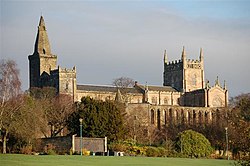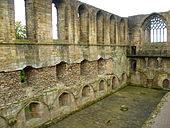Dunfermline Abbey
| Dunfermline Abbey | |
|
Dunfermline, Fife | |
|---|---|
 Dunfermline Abbey from Pittencrieff Park | |
| Church of Scotland | |
| Presbytery of Dunfermline | |
| Location | |
| Location: | 56°4’11"N, 3°27’49"W |
| History | |
| Built from 1128 | |
| Romanesque | |
| Information | |
| Website: | dunfermlineabbey.co.uk |
Dunfermline Abbey is a Church of Scotland Parish Church in Dunfermline, Fife. The church occupies the site of the ancient chancel and transepts of a large medieval Benedictine abbey, which was sacked in 1560 during the Reformation and permitted to fall into disrepair.
Part of the old abbey church continued in use at that time and some parts of the abbey infrastructure still remain to this day. Dunfermline Abbey is one of Scotland's most important cultural sites, as a royal foundation in what was once the capital of the kingdom, and the burial place of many of the Kings of Scotland.
Dunfermline Abbey was also the birthplace, in 1600, of King Charles I, the last British monarch born in Scotland.
History
Early history

The Benedictine Abbey of the Holy Trinity and St Margaret, was founded in 1128 by King David I of Scotland, but the monastic establishment was based on an earlier foundation dating back to the reign of King Malcolm III (1058-93) and his queen, St Margaret. At its head was an abbot, the first incumbent being Geoffrey of Canterbury, former prior of Christ Church, Canterbury, the Kent monastery that probably supplied Dunfermline's first monks. At the peak of its power it controlled four burghs, three courts of regality and a large portfolio of lands from Moray in the north down into Berwickshire.[1]
In the decades after its foundation the abbey was the recipient of considerable endowments, as seen from the dedication of 26 altars donated by individual benefactors and guilds and it was an important centre of pilgrimage after Dunfermline became a centre for the cult of St Margaret (Malcolm's wife and David's mother), from whom the monastery later claimed foundation and for which an earlier foundation charter was fabricated.[2] The foundations of the earliest church (the Church of the Holy Trinity) are under the present superb Romanesque nave built in the 12th century.
During the winter of 1303 the court of Edward I of England was held in the abbey, and on his departure next year most of the buildings were burned.[2]

Later history


During the Scottish Reformation, the abbey church was sacked in March 1560.
Some parts of the abbey infrastructure still remain, principally the vast refectory and rooms over the gatehouse which was part of the former city wall. The nave was also spared and it was repaired in 1570 by Robert Drummond of Carnock. It served as the parish church till the 19th century, and now forms the vestibule of a new church.
This edifice, in the Perpendicular style, opened for public worship in 1821, occupies the site of the ancient chancel and transepts, though differing in style and proportions from the original structure. Also of the monastery there still remains the south wall of the refectory, with a fine window. Next to the abbey is the ruin of Dunfermline Palace, also part of the original abbey complex and connected to it via the gatehouse.
Dunfermline Abbey has received more of Scotland’s royal dead than any other place in the kingdom, excepting Iona. The tomb of Queen Margaret and King Malcolm III, within the ruined walls of the Lady chapel, was restored and enclosed by command of their illustrious descendant and successor, Queen Victoria.[2]
Today

The current building on the site of the choir of the old Abbey church is a Parish Church of the Church of Scotland, still with the name Dunfermline Abbey.
Architecture

The old building was a fine example of simple and massive Romanesque, as the nave testifies, and has a beautiful doorway in its west front. Another rich Romanesque doorway was exposed in the south wall in 1903, when masons were cutting a site for the memorial to the soldiers who had fallen in the Second Boer War. A new site was found for this monument in order that the ancient and beautiful entrance might be preserved. The venerable structure is maintained publicly, and private munificence has provided several stained-glass windows. The architecture of Afghan church in Mumbai (dedicated to St. John the Baptist) has the door & the right side of the church taken from the Dunfermline Abbey.
Famous Births, Marriages, & Burials
- Queen Margaret (St Margaret of Scotland), 1093; on 19 June 1250 following her Canonization her remains were disinterred and placed in a reliquary at the high altar.
- King Malcolm III, whose remains were also disinterred and buried next to his Queen, Margaret.
- King Duncan II, 1094
- King Edgar, buried here in 1107
- King Alexander I, 1124, and his queen Sybilla de Normandy 1122
- King David I, 1153, and his queen Maud, Countess of Huntingdon, 1130
- King Malcolm IV, 1165
- King Alexander III, 1286, with his first wife Margaret of England, 1275, and their sons David, 1281, and Alexander, 1284
- Elizabeth de Burgh, wife of King Robert I, 1327

- King Robert the Bruce, 1329, in the choir
- Matilda, daughter of Robert I, 1353
- Anabella Drummond, wife of King Robert III and mother of James I, 1401
- Robert Stewart, Duke of Albany, 1420
Outside links
| ("Wikimedia Commons" has material about Dunfermline Abbey) |
- Dunfermline Abbey
- Dunfermline Presbytery
- Engraving of Dunfermline Abbey by James Fittler in Scotia Depicta (1804)
- Engraving of Dunfermline Abbey in 1693 by John Slezer
References
- ↑ Lamont-Brown Fife in History and Legend p.178-80.
- ↑ 2.0 2.1 2.2 Chisholm 1911.
Coordinates: 55°51′52.06″N 4°14′3.04″W / 55.8644611°N 4.2341778°W
